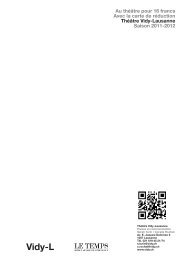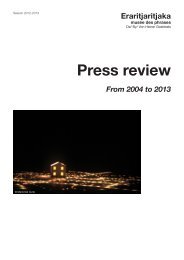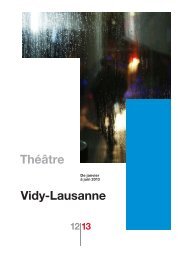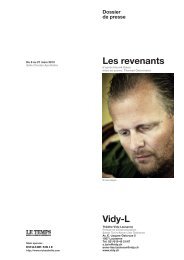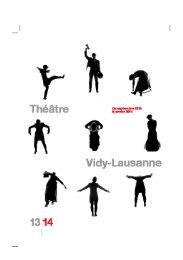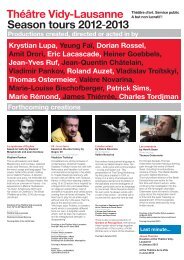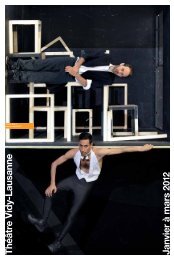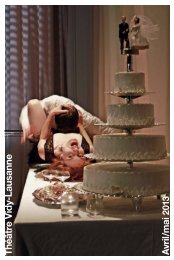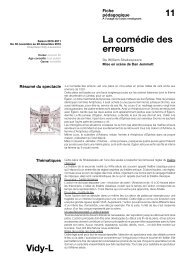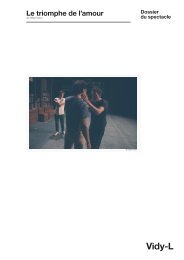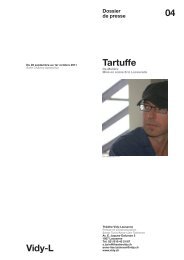Hashirigaki - Théâtre Vidy Lausanne
Hashirigaki - Théâtre Vidy Lausanne
Hashirigaki - Théâtre Vidy Lausanne
- No tags were found...
Create successful ePaper yourself
Turn your PDF publications into a flip-book with our unique Google optimized e-Paper software.
Saison 2011-2012<strong>Hashirigaki</strong>De/ By/ Von Heiner GoebbelsSüddeutsche Zeitung (DE)25.10.2000Der magische Soundpoet Heiner Goebbelshat mit «<strong>Hashirigaki</strong>» sein erstesMusical komponiert [...] SuperschönesGrün mit superschön gekritzelten Lichtprojektionen,superschöne Frauen in superschönenKostümen, die ständig gegenebenso superschöne ausgetauschtwerden: Reifröcke, Verpuppungshüllenund glitzergraue Overalls für Astronautinnen,das kommt noch in Mode, bestimmt.Dieses Angriffs auf die Augenkann sich nur erwehren, wer die Augenzumacht. Und da ist sie dann plötzlichwieder, die vertraute <strong>Hashirigaki</strong>-Tonspur,wegen der man zu Goebbels’ Aufführungenpilgert: Glockentöne, Gesang,elektronisches Vogelgezwitscher,von fern ein paar japanische Klänge, derSchrei einer Frau. Die Soundmaschinewird abgewürgt, eine Frau kippt um, dienächste Frau steht schon bereit. CharlotteEngelkes, Marie Goyette und YumikoTanaka bleiben dabei seltsam isoliert,nicht wirklich ein Trio, eher die drei vonder Punkstelle, jede für sich, sehr geschmackvollund sehr unnahbar...Plötzlich nämlich wird der abend leichtund hebt ab. Großstadtzitate aus Pappezieren die Bühne: Wolkenkratzer, eineKathedrale, eine Fabrik. Eine Papp-Bus-Silhouette wird quer über die Bühne getragen,und wenn man jetzt ganz genauhinsieht, kann man sehen, daß Frauenaus den Fenstern schauen - in einerSekunde, da man noch nichts von ihnenweiß.«Come close, close your eyes and bestill. Don’t talk, take my hand, and listento my heart... beat... Listen. Listen.Listen.» Das sind nocheinmal die BeachBoys. Sie haben über «<strong>Hashirigaki</strong>» allesgesagt.
Saison 2011-2012<strong>Hashirigaki</strong>De/ By/ Von Heiner GoebbelsSüddeutsche Zeitung (EN)25.10.2000[...] There is one second where theydon’t know anything from each other,one moment only, then they meet eachother’s gaze, on a narrow path in frontof a wall with two doors opening andclosing: three women play many women,for example the woman with themarket basket, the woman with thepotted plant, the woman with the tuba,the woman with the surfing board. Theyappear, and they go away. These womenare like an accessory sound that alreadydisappears when we just noticed it. Buttheir steps, strengthened by the electronic,produce a constant rhythm; itis the rhythm of the passage, and it iscomforting. Because even though noneof these women can be stopped, oneknows it: the next will come soon.The poet and sound magician HeinerGoebbels composed with <strong>Hashirigaki</strong>his first «musical». The title comes fromthe Japanese language, from the kabukiplay «Dead in Amijima» of Chikamatsu,and means on the one hand «to hurry»and on the other hand «to write fluidly,to sketch»; one could also say: on theone hand «passage», on the other hand«sound composition», as one knows it byGoebbels, this handyman of the modernworld sound space, that pulls everythingthat resounds and collides in its cosmos,makes it appear and quickly disappearagain. A maniac of the «way through»who pricks up his ears in all directions,without getting lost. The passage followsits own laws, an element brings theother, and one can hardly remember thatit’s already the end.Last year during the week of the Berlinradio game, Heiner Goebbels told a lotabout himself, without speaking of himself.He talked about Jean-Luc Godardand the sound track of «La NouvelleVague»; the whole movie is on CD, andone can hear that Godard composesits world in the same way as Goebbels.During his conference, Goebbels kepthis finger on the tape recorder, forward,reverse, one afternoon with two minutesof movie: a cello, voices, a car door closingitself, some dogs barking, a womanshouting; one could call that «atmosphere».Goebbels said: «The problem isalways: how to avoid the impact [the fallor the raid]? I find it terrible, when onehas an idea, that he can finally not assureit. That’s why I try and find severalreasons for every composition, for everysubject». The method for making this iscalled <strong>Hashirigaki</strong>.During the first German performance of<strong>Hashirigaki</strong>, at the Schauspielhaus ofHamburg, one must definitely admit thathe is completely impressed. It is as ifGoebbels this time had polished its passageuntil the maximal burst, and thiswithout moving back from the handicraftas soon as the scene of Klaus Grünbergbends itself toward a horizon illuminatedby an astounding beauty, it lookslike the kit of makeup of Bob Wilson.An extra-beautiful green with luminousprojections in extra-beautiful spirals,extra-beautiful women in extra-beautifulcostumes, constantly swapped withothers just as extra-beautiful: crinolines,chrysalis envelopes, metallic grey overallsof spacewomen, it will certainly bein vogue.One can only defend himself against thiseyes attack by closing his lids. And herecomes again the familiar <strong>Hashirigaki</strong>tonality, for which one makes pilgrimageto Goebbels’ performances: ringingof bells, songs, electronic chirping ofbirds, some Japanese sounds far away,a woman’s scream. The sound machinesuffocates, a woman disappears, andthe next one is already ready. CharlotteEngelkes, Marie Goyette, and YumikoTanaka remain oddly lonely, not really atrio, but rather three points of a shape,each for oneself, with a lot of good tasteand no closeness.Goebbels seems to have told himselfthat if it must be a musical, then it can bealso somewhat smoothed. Even whenhe calls in Gertrud Stein and her novel«The Making of Americans», continualrepetitions don’t give any freedom to thesignification, but to the rhythm and thesound of the words. There is not muchto tell in that, there is more to hum. Butthe aesthetic of the wanted extra-beautifulsuffocates the pop music that isotherwise quite like at home. Anyway, itdoesn’t take long until the beautiful musicof the Beach Boys resounds, withoutvoice, purely instrumental : «God onlyknows what I’ll be without you». In fact,the evening becomes suddenly light andit takes off. Passages of big cardboardcities decorate the stage: skyscrapers, acathedral, a factory. A cardboard bus silhouetteis carried across the stage, andif you take a precise look at it, you cansee that some women are looking out ofthe window; just a second during whichone doesn’t know yet anything aboutthem.«Come close, close your eyes and bestill. Don’t talk, take my hand, and listento my heart» beat. Listen. Listen. Listen.«Here come the Beach Boys again. Theysaid everything about <strong>Hashirigaki</strong>.Ralph Hammerthaler
Saison 2011-2012<strong>Hashirigaki</strong>De/ By/ Von Heiner GoebbelsTheater Heute (DE)12.2000Für Männerhände viel zu schadeHeiner Goebbels bringt Japan und GertrudeStein nebst drei Performerinnen ineinen musikalischtheatralischen Zusammenhang- «<strong>Hashirigaki</strong>»Haus und Hand sind das Thema von HeinerGoebbels’ «<strong>Hashirigaki</strong>». Wohnen und Städtebauen einerseits, Möbelpflege, Hautpflegeund Sozialpflege von zarter Hand andererseits.Vage, aber nicht ungenau gibt dasBühnenbild städteplanerische Dreifaltigkeitvor: eine Hausfront, ein Innenraum, in dem irgendwannkleine Spielhäuser aufgestellt werden;schließlich Außen, Straße, ein Bus. Dazukommt eine geographische Bewegung: Wasmit amerikanischer Musik von den BeachBoys beginnt, verlässt Kalifornien RichtungWesten und landet im Osten, in Japan. GertrudeSteins Texte schauen derweil, hat manden Eindruck, der ganzen Welt von oben zu.Innen und Außen sind keine psychodramatischenArenen, eher unterschiedliche Gradevon Entspanntheit. Sowohl die Musik vonBeach-Boys-Chef Brian Wilson wie die Textevon Gertrude Stein werden wie unaufgeregteLockerungsübungen eingesetzt. Drei Performerinnen,Charlotte Engelkes, Marie Goyetteund Yumiko Tanaka, bringen dieses Geschehenin Bewegung, weitgehend ohne sichzu verkrampfen. Hält man sie zunächst nochfür Darstellerinnen, die in einer erzähltheatralischenKulisse agieren, verwandeln sie sichdoch bald in Performerinnen, die selber füreinen großen Teil der Musik, den ganzen Gesangund den Bühnenaufbau sorgen. GegenEnde, wenn die Möglichkeit von Illusion undFiktion zumindest angedeutet wird, könnteman sie auch wieder als Schauspieler in einerpostdramatisch gelesenen Rolle verstehen.Diffus unrepräsentativ.Vor allem, wenn die drei musizieren, erinnernsie mich an das Künstlerinnen-Trio «DiazentraleOst», das sich zu Beginn der 80er undbevor irgend jemand in Deutschland CindySherman kannte, zu immer anderen klischeehaften,genre-bezogenen Frauentrios zusammenfand,für Fotos und Performances zufiktiven Sportlerinnen, Tänzerinnen, Berufsgruppenoder Bands gestylt. Dabei standendie drei Künstlerinnen auch immer leichtamüsiert neben sich - und waren doch sehrkonzentriert. Hier kommen auch Spiele dazu,bei denen zwei sich mehr gleichen als diedritte, meistens die japanische Darstellerin,die zuweilen eigene Aufgaben bekommtoder ihre Perücke anders trägt. Auch dieseDifferenz zwischen den beiden westlichenund der östlichen Darstellerin birgt viel kulturalistischesGlatteis. Doch das rutschigeParkett einer Exotik-versus-Normalität-Gegenüberstellungwird nicht bewältigt, indemes umgangen wird. Diese Differenz und diesie erst in dieser Gestalt in Welt und Bühnesetzenden Projektionen werden markiert,vorgestellt - aber ohne eine These oder Gegenthesedamit zu verknüpfen. Meinungslosrelaxt. Wir wissen, dass das nicht so einfachist, oh ja, aber hier ist es und so ist es und nunkommt das nächste. So in etwa der Textgestusvon Gertrude Stein.Zusammengehalten wird der locker gesponnenemusikalisch-assoziative Reigen nunzwar vor allem von den drei Performerinnen inihrer Eigenschaft als multifunktionales Darstellerinnen/Musikerinnen/Bühnenarbeiterinnen-Trio,das fast immer komplett anwesendist. Dieses erinnert aber nur zum einen an feministischePerformance-Kunst, zum anderenist es eine Band, die immer wieder musiziertund sich zu Musik verhält, meistens kommtdie von dem legendären Beach-Boys-Album«Pet Sounds», aufgenommen zwischen Sommer‘65 und Frühjahr ‘66. Diese Sounds bildenden anderen Zusammenhalt.«Pet Sounds», das sind Streichelsounds, zarteBerührungen. Als die Beach Boys ihr gleichnamigesAlbum aufnahmen, verzichteten sienahezu vollständig auf ein konventionellesRock-Schlagzeug. Der gestandene Jazz-PerkussionistHai Blaine musste auf Geheiß vonBrian Wilson - der dieses Album mehr als allevorangegangenen dominierte und teilweiseganz ohne seine Brijder und Cousins, sondernmit berühmten Gästen wie Glenn Campbellund Barney Kessel aufnahm - das normaleDrum-Set durch alle möglichen Percussion-Instrumente ersetzen: Rasseln, Marracas,diverse Tambourine und Zymbeln, Xylophoneund zart gestrichene Becken. Dazu hatte dererfahrene Blaine, der auf 362 Charts-Hitsmitgespielt hatte, von «Bridge Over TroubledWater» über «Mr. Tambourine Man» bis«Strangers In The Night», eine große Tütedabei, die er seinen «Bag of Tricks» nannte,mit 20 weiteren extrem seltenen Percussion-Instrumenten, die bei diesen Sessions punktuellEinsatz fanden. Raschelnde, zischelnde,verwischende, klingelnde Percussions tragenauch die Performerinnen von «<strong>Hashirigaki</strong>»mit sich herum, zuweilen in direkter Verlängerungeines Hal-Blaine-Schlages.Das Konzept des Pop-Schlagzeugs ist bei«Pet Sounds» zeitweise so durchlöchert,dass man das Gefühl hat, jeder Beat wird voneinem anderen Instrument hervorgebracht,wenn denn die Percussions nicht sowiesoetwas ganz anderes tun, als den Beat zubetonen, und uns mit extrem psychotropenGeräuschandeutungen das Cranium massieren.Ja, das waren die Pet Sounds, dieHirnrindenechos einer besonders melancholischenSeele, der des fettleibigen, viel zubegabten und übersensiblen Brian Wilson,der zu allem Überfluss auch noch das Lebeneines Pop-Stars führen musste. Sein ausgesprochenverzärtelter, aber nie unpräziser Sinnvon Beat scheint auch diesem Stück seinenstets spürbaren, aber nie sehr markantenRhythmus zu geben.Heiner Goebbels hat sich für «<strong>Hashirigaki</strong>»einer Platte bedient, die kommerziell ein Flopwurde, den Beach Boys ihr Image als unbeschwerteKinder des Strandes mit einer ÜberdosisSchwermut zerschoss und künstlerischdurchfiel, weil sie den Zeitgenossen als «zubritisch» galt. Doch sie ist seitdem mehr alsjede andere Pop-Platte immer wieder zurbesten aller Zeiten gewählt worden. Seit inden 90ern Musikzeitschriften, Lexika und Kritikerdamit anfingen, Pop-Geschichte zu bilanzieren,wurde «Pet Sounds» immer wiederden Beatles, Elvis, Sinatra, Hendrix und Dylanvorgezogen und gewann auch schon mal denVergleich gegen E-Musik und Jazz, wennnach Jahrhundertplatten gefragt wurde. Diesermassive Nachruhm und die unzähligen,den Beach Boys der späten 60er nacheiferndenBands der Gegenwart veranlasstenCapitol Records, 1996 zum 30. Jubiläum einluxuriöses, historisch-kritisches 4-CD-Set zuveröffentlichen, das zu knapp drei Viertelnaus Proben und Backing Tracks ohne Gesangbestand. Dieses Material, genauer dieBacking Tracks von «Caroline No», «l KnowThere’s An Answer», «Don’t Talk (Put YourHand On my Shoulder)», «I Just Wasn’t MadeFor These Times» und das Instrumentalstück«Pet Sounds» bilden den musikalischenGrundstock des Goebbels-Stücks. Californiameets Japan. Die drei Performerinnen eröffnen«<strong>Hashirigaki</strong>» zu diesen instrumentalen«Pet Sounds» mit einer Art Hausputz. Sie räumenGegenstände durch Fenster und Türeneiner bühnenfüllenden Fassade und schauendabei so aufgeräumt, so optimistisch wie dieTexte von Gertrude Stein, die sie zwischendrinzum Besten geben. Diese stammen vorallem aus «The Making Of Americans», undich hatte schon vergessen, wie gut die eigentlichsind. Sie passen zu den Beach Boys-Hintergründen, die Goebbels unverändert,höchstens ein bisschen verlängert laufenlässt, schon deswegen so gut, weil sie soohne jeden Drang, ohne jede Überzeugungund Ideologie endlos iterieren und permutieren,wie die leisen Leichtfüßigkeiten der «Pet
Saison 2011-2012<strong>Hashirigaki</strong>De/ By/ Von Heiner GoebbelsTheater Heute (DE)12.2000(Next)t Sounds».Sie übertragen aber auch ein bisschen dieStimmung des einen (maßlose Melancholie)auf die des anderen (aufgeräumt amerikanischeAnerkennung der Tatsachen), so dassman beide miteinander verwechseln kann.Oder die eine Stimmung für den Kern deranderen halten. Wer sich so in seine Melancholiefallen lassen kann und sie so bis zurNeigung kostet, dass er sie gestalten kann,wird vielleicht von einem - womöglich kalifornischen- Kokon der Bejahung geschützt.Wer derart musikalisiert und repetitiv seinepositiven Daten und Deskriptionen so ununterbrochenund unerschrocken durch seinestrengen Strukturellen nudelt, singt vielleichtnoch von etwas anderem. Wenn bei Goebbels’Stein immer wieder von «Little Ones»die Rede ist, wenn immer wieder die Optikeiner freundlichen, mildeamüsierten und auchaufmerksamen, ja sehr interessierten, dochunerschütterlichen Großtante eingenommenwird, bleibt auch immer etwas emotionalungeklärt. Diese Fröhlichkeit darüber, sich zudieser Wiederholung der Wiederholung desFaktischen durchgearbeitet zu haben! Wiedieser produktive Mangel der Stein-Textedann wiederum in den Hammerklavier- undXylophon-Geflechten der Beach Boys räsoniert,ist sehr beeindruckend. I know thisdistinction, it has real meaning, I am sayingit again and again and now I begin again witha description.Danach geht es aber richtig ins Innere. InsInnere des Hauses wie der Seelen. Dort istJapan. Die twomblysierende Krakel-Kalligraphieam Bühnenrücken gibt den Ton vor fürdie für meinen Geschmack etwas überpoetisiertePhase, die nun eine Weile vorherrschenwird. Tänze mit Kissen: vielleicht etwaszu weich und ohne räsonierendes Geräusch.Dass es durch die amerikanische Tür nachJapan geht, ist die eine, die andere Lesart die,dass es innen eben einfach japanisch zugeht.In uns, im Zentrum der Wilsonschen Melancholieebenso wie in dem der SteinschenPermutationen raschelt ein Haiku im Wind.Mit einer lakonischen Laute um die Wette. YumikoTanaka singt nun japanische Lieder undbegleitet sich auf einem japanischen Instrument.Von Lied wie Instrument wissen wir nur,dass sie traditionell sind. Natürlich sind auchdies «Pet Sounds» - eine japanische Traditionüberdies, jeden größeren Garten Kyotos sozu gestalten, dass noch die herabfallendenTropfen eines Zierflüsschens zart auf einemMoos landen, welches sie weich auffängtund dann ein ebensolches, aber doch ganzbestimmtes und wohl kalkuliertes Geräuschergibt.Gewaltlos wird der Raum wieder etwas robustergemacht. Bald sind die drei wieder einmusizierendes Trio. In der Mitte wird ein Thereminbeschworen. Dieses sehr frühe elektronischeInstrument, von dem gleichnamigenrussischen Physiker erfunden, dessen Doppelagenten-Lebenzwischen Stalin, CIA, KGBund Synthesizer-Erfinden vor ein paar Jahrenin einem bemerkenswerten Dokumentarfilmbeschrieben wurde, passt natürlich ins Zentrumder Bühne wie des Stücks ganz besondersgut, weil es ohne eine direkte Berührunggespielt wird. Die Musikerin spielt das Gerät,indem sie ihre Hand oder andere Körperteilein der Nähe des elektronischen Instrumentsbewegt. Natürlich ist es das ideale Instrumenteines jeden expressiven Performers oderTänzers, aber kaum jemand bringt etwasanderes hervor als mehr oder weniger zufälligeSound-Effekte. Eigentlich konnte nur dievor zwei Jahren verstorbene russisch-amerikanischeViolinistin Clara Rockmore auf demTheremin eine Partitur umsetzen. Als dasTheremin vor dem zweiten Weltkrieg so eineArt futuristisch musikalische Jahrmarkts-Attraktionwar, gab es öffentliche Vorführungenseiner Wirkung, bei denen meistens attraktiveFrauen die Klangerzeugung demonstrierenmussten.Bevor das Gerät in den 90ern wieder in Modegeriet, waren es natürlich auch wieder nur dieBeach Boys, die es für einen entscheidenden,sirenenartigen Sound-Effect in «Good Vibrations»einsetzten. Bei «<strong>Hashirigaki</strong>» gerät dasTheremin-Gefuchtel zu einer Hände-Performanceim großen Stil. Die Luft walken undkneten, streicheln und halten - für Männerhändeviel zu schade. So gelungen diesePerformance für sich war, so sehr zeigte sichin ihr dann doch das Problem eines amüsierten,nun aber generellen und nicht mehr spezifischSteinschen Großtanten-Blicks auf das,was die Ladies so tun, wenn sie allein sind.Auch wenn es sonst dem Stück immer gelingt,auf sehr angenehme, entschiedene, aberleichte Weise jeder Lesart einer geschlechtsessentialistischenFrauenverkitschung alsStreichel- und Haushaltsexpertinnen desInnen den Boden zu entziehen. So rutscht eszuweilen doch auch in ein arg süßes Lob derschönen weiblichen Seele, zumal auch dieleichte Ironie, mit der die Performerinnen zuWerke gehen, sich auf kein erkennbares - zuironisierendes - Gegenüber bezieht. In ihrerUnbestimmtheit wird sie affirmativ.Zeit vergeht. Jetzt sind die drei wiederganz den Klängen der Beach Boys, beziehungsweisedes von Brian Wilson arrangiertenOrchesters ausgesetzt. Eine Stadtaus kleinen Papp-Häusern, dann eine Bushaltestelle.Häuser werden von Händenhingestellt, arrangiert. Der große Papp-Buskommt, nimmt mit, bringt zurück. Die Performerinnensprechen wieder Stein-Texteoder singen Original-Beach-Boys-Gesangspartsmit charmant unterschiedlichem Erfolg.Diese Konfrontation der Stein-Texte mit demBeach-Boys-Backing klingt nun fast wie eineneuere Robert-Ashley-Oper («Your Money MyLife Goodbye» zum Beispiel). Allerdings wieeine Version, bei der das britische Trio St.Etienne mitgemacht hätte. Man muss nunöfters an andere, eigentlich von einanderentfernte, nun aber viel näher gerückte Performer,Pop-Bands und Poeten denken. DerZusammenhang zwischen Beach Boys undStein, zwischen Pazifik und Paris hat offenbarnoch für anderes Platz. Man stellt sich gernvor, dass da, wo sie dieses Stück herhaben,es noch mehr davon gibt. Trotzdem war esnicht die Versöhnung zweier Welten, sondernein Einblick in ein nettes Zimmer, das bei allerVertrautheit auch ganz unbekannt war.Die einzige Gefahr - in diesem Text wie inder Inszenierung, die er beschreibt - bestanddarin, diese Zimmer-Utopie ein bisschen zuverklären.(Dietrich Diederichsen)Dietrich Diederichsen
Saison 2011-2012<strong>Hashirigaki</strong>De/ By/ Von Heiner GoebbelsFrankfurter Allgemeine Zeitung (DE)26.05.2001AgressionsfreiMoskau grüßt Heiner Goebbels:«<strong>Hashirigaki</strong>» begeisterte im Mossowjet-Theaterdas PublikumDer nächste Nachbar der Avantgardeist die Kinderzeichnung. Das minimalistischeDrei-Frauen-Musiktheaterstückvon Heiner Goebbels mit dem mystifizierendenTitel «<strong>Hashirigaki</strong>», von derheimischen Kritik mit gereizter Ratlosigkeitzur Kenntnis genommen, hat, inMoskau im Rahmen der «Theater-Olympiade»aufgeführt, ein für seine konservativenAnsichten bekanntes Publikumbezaubert. Die szenische Rezitation ausGertrude Steins repetitiver Prosa «Makingof Americans», verfremdete BeachBoy-Songs und elementare, exotischesowie elektronische Klänge erzeugtenfür die des Englischen kaum mächtigen,für mystische Wirkungen aber um soempfänglicheren Zuschauer einen meditativenKlangteppich. Sich jeglicheremotionaler Prätention enthaltend, trugdieser ein dankbares Publikum durchein aus Lichtprojektionen und schlichtenRequisiten mit leichter Hand skizziertesBilderalbum über die Normalexistenzdes modernen Homo sapiens.Ob die ausgefallenste Güter auf Nimmerwiedersehenverschlingende schwarzeKonsumwand der Eröffnungsszene,ob das von grellen Inspirationsblitzenimmer wieder ausgeblendete Wissensgekrakel,ob die priesterliche Transformationdes glühenden Becken-Herdesaus einem Elektroschockschrei oder dieBeschwörung und Zerstörung kultischerBilder in der Gestalt von Glocken undBronzespiegeln: Die durch kein dramaturgischesFeinschmeckertum belasteteMenge verfolgte das heiter-besinnlicheBühnengeschehen mit unvoreingenommenerAnteilnahme, gemahnte es dochin seiner unauflöslichen Rätselhaftigkeitan das Leben selbst - unter Abzug derAggressivität. Diese von dem Darstellerinnen-Triofern des in Rußland verachtetenFeminismus erzeugte weiblicheQualität weiß man in einer polaren Kultur,die von einem brutalen Alltag undutopischen Träumen geprägt ist, besonderszu schätzen. Es war anerkennendgemeint, als die Kritik das Stück an derGrenze zwischen Mary Poppins undAlice im Wunderland verortete.Die Traurigkeit der menschlichen Komödieerscheint in dieser mozarthaftenFernsicht auf das Erdentreiben homöopathischverdünnt. Der russische Bildungsbürger,geschult am nationalenDichteridol Puschkin, der seine Melancholietief in poetische Spielereien zuverstecken versteht, vernimmt sie aberdoch. Als Spur ertönt sie in der grellbuntkostümiert vorgetragenen Pop-Romanze,beinahe verlegen in der Abendeinsamkeitvor der Pappstadtkulisse.Und als im Entropie-Finale, da eineGeistesglühbirne aus ihrem kreisendenGitterkäfig Schattenspiele auf weißeWände wirft, die drei mit Balsamstimme«I wasn’t made for these times» intonieren,bleibt von ihr anmutige Gefaßtheitübrig, was manchem aufgeklärtenDeutschen allzu leichtgewichtig erscheinenmag, rührt im unzivilisierten Rußlandan selten in Schwingung versetzte, aberempfindsame Saiten.(Kerstin Holm)Kerstin Holm
Saison 2011-2012<strong>Hashirigaki</strong>De/ By/ Von Heiner GoebbelsThe Guardian (EN)28.08.2001If the release of the Beach Boys’ 1966album Pet Sounds was one of the seismicevents of your musical youth, andif you think that God Only Knows is stillthe greatest pop song ever written, thenHeiner Goebbels’s new theatre piecewill be 80 minutes of pure, unadulterateddelight.For those without direct access to thatparticular bag of nostalgia, it must stillrepresent a quite remarkable achievement.<strong>Hashirigaki</strong> is a fusion of extraordinarilydiverse cultural elements - theBeach Boys’ songs, Japanese folk musicand Gertrude Stein’s mammoth novelThe Making of Americans - broughttogether with Goebbels’s characteristicalchemy.The whole thing is presented by threewomen who act, sing, dance and play ina ravishing visual setting that holds theaudience enchanted from the first surrealimage to the last.The piece was brought to Edinburgh forjust two performances by Théâtre <strong>Vidy</strong>-<strong>Lausanne</strong>, which presented the worldpremiere last year. The Japanese title iselusive - with connotations of running,rushing and writing fluently, it’s the firstword of a famous kabuki drama, andseems to encapsulate the way in whichGoebbels makes his allusive mix cohere.His starting point was not, in fact, PetSounds itself, but a set of CDs thatemerged more recently, detailing thesessions and out-takes that went intothe making of the classic LP.The unearthly singing of the BeachBoys is never heard in <strong>Hashirigaki</strong>, butthe backing tracks haunt the sculptedsoundscape, in which the theremin, anearly electronic instrument used on PetSounds and then immortalised by thesame band on Good Vibrations, playsan important role.The yearning opening of God OnlyKnows launches a series of Stein’stypically opaque fables, delivered withwonderful deadpan seriousness; Don’tTalk becomes a song-and-dance numberas the women don outrageous wigsand turn themselves into a Ronettesstyletrio; I Just Wasn’t Made For TheseTimes is the essence of the lingering,intensely poetic epilogue.The Japanese folk numbers provide thecool counterweight but, as remarkablekoto player Yumiko Tanaka shows, thatsoundworld can metamorphose intoa fine replica of bluegrass music in aninstance. Cultural boundaries - betweeneast and west, popular culture and highart - are dissolved.Everything becomes part of a uniquedramatic world, in which the array ofarresting gestures and movements -akin to Robert Wilson’s theatre, but withgentle, affectionate wit replacing his tendentiousness- knits everything together.The three performers (Tanaka, Swedishsinger and dancer Charlotte Engelkesand Canadian pianist Marie Goyette)are extraordinary in their versatility andpoise, and have been signed up to bringthe show to London’s Barbican beforetoo long. Book as soon as the dates areannounced, because <strong>Hashirigaki</strong> is anunclassifiable, unforgettable experience- the stuff that masterpieces are madeof.Andrew Clements
Saison 2011-2012Press review<strong>Hashirigaki</strong>De/ By/ Von Heiner GoebbelsThe Guardian (EN)21.12.2001The year in classical musicPerhaps by now we should have learnedto be grateful for small mercies. Thecollapse that has so frequently beenpredicted for the classical-music worldfailed to materialise for one more yearat least, though the aftershocks of September11 are already having an effecton funding. Even the record industryremained largely intact, though one distinctivelabel, Nimbus, went to the wall,and some of the major companies havebeen streamlining their outputs so thatthere are regular reports of high-calibreperformers finding themselves without arecording contract.That’s not to say, though, that it hasbeen a vintage year for British music.There have been few great changes inthe fortunes of London orchestras; theLSO has continued to produce work ofthe highest calibre with Colin Davis asits chief conductor, and is benefitingfrom having its home at the acousticallyremodelled Barbican, where there is areal sense of enterprise and imaginationabout the artistic planning. The Philharmoniaand the London Philharmonic arestill struggling to preserve their distinctiveprofile on the South Bank, which, inthe year the Festival Hall celebrated its50th anniversary, seems more bereft ofcreative ideas and guiding managementthan at any time in its existence.It has been a good year for the regionalorchestras: the Bournemouth Symphonyhas found itself a sensible newchief conductor in Marin Alsop, the Cityof Birmingham Symphony and SakariOramo are at last settling into a fruitfulpartnership, and now have Julian Andersonas composer-in-association, whileafter only a few months the Hallé in Manchesteris starting to reap the benefits ofhaving secured Mark Elder as its musicdirector.Not much excitement in opera, either.While the Royal Opera seems to bemarking time until the arrival of AntonioPappano next autumn, it came up withtwo classy new productions: NikolausLehnoff’s staging of Hennze’s BoulevardSolitude, and David McVicar’s Rigoletto,as well as a Parsifal - conducted by SimonRattle, who this summer finally signedhis contract at the Berlin Philharmonic- that was by all accounts first ratemusically but uninspired dramatically.But the visit of the Kirov Opera to CoventGarden for a Verdi season in July was adisappointment, musically indifferentand theatrically more or less inept.English National Opera had a mixedyear, with new shows ranging fromthe abject (a Marriage of Figaro thatshould have been aborted in rehearsals)through the controversial (CalixtoBieto’s staging of Don Giovanni, whichoutraged many but was full of fresh and- literally - penetrating ideas) to the firstrate (McVicar’s Rape of Lucretia and TimAlbery’s staging of Prokofiev’s War andPeace, a white elephant of a piece thatnevertheless showed the company at itsbest). ENO was also the one major operacompany to manage a premiere in 2001- David Sawer’s From Morning to Midnight,which in the event was somethingof a disappointment from such a promisingcomposer.It was a less than remarkable year fornew music: Aldeburgh presented theBritish premiere of Alexander Goehr’soperatic double bill, Kantan and DamaskDrum, but did it no service by clothingit in a production of utter fatuousness.Goehr was also one of the composersfavoured with a Proms commission,which were generally unremarkable;out of the 20-odd new works it is hardto identify one that is likely to be heardoften again.So the indelible memories to take awayfrom the year are relatively few - justthree, in fact. Krystian Zimerman’sBrahms and Beethoven piano recital atthe Festival Hall in June was final proof, ifit were still needed, that Zimerman meritsa place among the greatest pianists ofall time. The arrival of the Chicago SymphonyOrchestra and Daniel Barenboimat the end of the Proms for two concertsfinally galvanised what had been an underwhelmingseason with playing of thehighest class. Best of all for me, though,was Heiner Goebbels’s latest theatrepiece, <strong>Hashirigaki</strong>, a highlight of an Edinburghfestival otherwise full of operas inconcert performance; Goebbels bringstogether Gertrude Stein and the BeachBoys in a magical synthesis that, like allthe greatest art, is utterly unclassifiable.Andrew Clements
Saison 2011-2012Press review<strong>Hashirigaki</strong>De/ By/ Von Heiner GoebbelsThe Wire (EN)01.2002Huddersfield Contemporary MusicFestival - Huddersfield Various venues.[...] But the highlight of the festival wasHeiner Goebbel´s wonderful, enchanting<strong>Hashirigaki</strong>, performed at the LawrenceBatley Theatre. You might know Goebbelsfrom last year´s Surrogate Citieson ECM, and as the composer of radiosound art in Germany, but in a talk afterwardsdescribed himself modestly asa compiler of music: outtakes fromtheBeach Boys` Pet Sounds album setalongsiede Japanese folk music. Thethree theatre actress/singer/dancers -Marie Goyette, Charlotte Engelkes andYumiko Tanaka - recited texts from GertrudeStein´s The Making of Americans,in a well-enunciated and almost patronisingdelivery. Goebbels is a man ofthe theatre as much as a composer, andmusic and words were unified in a delightfullyabsurdist, make-believe worldof play, owing as much to Teletubbiesas any contemporary American drama.Balloons and bells decended from theceiling, one of the players took an imaginaryshoe-box dog for a walk, and acardboard cutout bus ´driven´ ´by a nonchalantgum-chewing driver appearedon stage to take the three players on ajourney. A darker tone was set for theclosing scene, lit by a single garish lightbulb, but as for the message I wouldn´tcare the guess - maybe there wasn´tone. Lighting an sets were perfect. Unfogettablebut sadly there was only oneperformance. You had to be there.Andy Hamilton
Saison 2011-2012<strong>Hashirigaki</strong>De/ By/ Von Heiner GoebbelsThe Guardian (EN)21.11.2002<strong>Hashirigaki</strong>Heiner Goebbels’ music-theatre piece<strong>Hashirigaki</strong> is a virtuosic mix of cultures,sounds, and images. It fuses excerptsfrom Gertrude Stein’s The Making ofAmericans with songs from the BeachBoys album, Pet Sounds; and it isstaged for three female performers whoare simultaneously musicians, dancersand actors. That combination suggestssome kind of commentary on Americanculture, or a metaphor for contemporarymulticulturalism. Yet, in reality,<strong>Hashirigaki</strong> is much less about social orpolitical meaning than the creation of acompelling but elusive theatrical world.The show is full of magical musical andvisual moments.Seeing The Beach Boys’ I Just Wasn’tMade for These Times sung in Europeanand Japanese accents, played bya theremin and a collection of bells, andaccompanied by the original backingtrack, is a thrilling and weird experience.Yet this unexpected meeting of culturesemerges completely naturally withinthe context of the rest of the 75-minuteshow. In one sequence, the threeperformers, Charlotte Engelkes, MarieGoyette, and Yumiko Tanaka, transforma suite of Japanese and western instrumentsinto a miniature cardboard city:an organ becomes a skyscraper, andTanaka’s costume turns her into a towerblock.After a passage of ritualised violence,in which Tanaka furiously beats a metaldisc, the action morphs seamlessly intoa version of another Beach Boys track,Don’t Talk. Every aspect of the productioninhabits the same allusive universe:from Stein’s repetitive texts to Florencevon Gerkan’s suggestive costumes,which transform the performers intoeverything from giant, luminous eggsto boiler-suited workers. The theatricalrange encompassed by Engelkes,Goyette, and Tanaka is stunning. Theymake Stein’s texts sound genial andconversational, their actions and movementsare brilliantly coordinated, and Tanaka’smastery of a variety of Japaneseinstruments is spellbinding.From all of this diversity, Goebbelscreates an inexplicable but coherenttheatrical grammar, one that includeshumour and emotion. In one section, Engelkesand Goyette move in an undulatingwave across the apron of the stage,as they recite a text that muses on theniceties of language and pronunciation.After a long silence, a shout of Mexico!in a Spanish accent is bizarrely, butgenuinely, funny. Their version of CarolineNo is strange and moving, as theyaccompany their vocals with a delicateembellishment of finger cymbals andexotic percussion.But the most powerful sounds in <strong>Hashirigaki</strong>are those of the theremin: noisesof this ethereal, electronic instrumentencapsulate the mysterious world of thewhole show.Tom Servic
Saison 2011-2012<strong>Hashirigaki</strong>De/ By/ Von Heiner GoebbelsFrankfurter Allgemeine Zeitung (DE)31.12.2002Aus Instrumenten eine Stadt gezaubertHeiner Goebbels zeigt sein Musiktheaterstück«<strong>Hashirigaki</strong>» imSchauspiel FrankfurtFür einen Moment bleiben die Musikinstrumenteverlassen auf der Bühnezurück, bevor sie auf wundersameWeise verwandelt werden. Drei Frauenin geometrisch ausgestellten Röckentragen aus Pappe gefertigte Häuserauf die Bühne, einen Kirchturm, eineFabrik, aus deren Schornstein kleineWölkchen aufsteigen. Das Theremin,das eben noch mit seinen gleitendenTönen die Luft in Bewegung versetzte,verschwindet ebenso wie die japanischeZitter hinter einer Hauswand, Auf dasindische Harmonium wird kurzerhandein Dach gesetzt, der Gong wird zumVorderrad eines Autos umfunktioniert,das Glockenspiel mit seinem verziertenGestell ziert die Fassade eines Hauses,und die Trommel landet auf dem Dacheines Turmes, bis eine ganze kleineStadt entstanden ist, die wie auf Wölkchengebettet über die große Bühne desFrankfurter Schauspielhauses schwebt.In Heiner Goebbels Musiktheaterstück«<strong>Hashirigaki</strong>», das nach seiner Premierevor zwei Jahren in Genf nun endlichauch in Frankfurt zu sehen ist, ist dieseStadt aus Musikinstrumenten auch eintreffendes Bild für die Klangarchitektur,um die es Heiner Goebbels hier geht.Vieles, was an diesem Abend zu hörenist, ist eine szenische Erweiterung des anZwischentönen reichen Klangspektrumsder epochalen Platte der Beach Boys,«Pet Sounds», die im Sommer 1966 mitihren weichen, transparenten Klängen,die sich zu einem ebenso dichten wiefiligran abgestuften Klangraum überlagern,den musikalischen Entwicklungender Beatles um Haaresbreite voraus war.In «<strong>Hashirigaki</strong>» verbindet Goebbels dasHängende, Schwebende der Musik derBeach Boys mit dem Unabgeschlossenen,Offenen der Sätze von GertrudeStein. In ihren «Landscape Plays» beschwordie Mutter der amerikanischenAvantgarde die Erfahrung eines endlosenSchreibens ohne dramaturgischenAnfang und zwingendes Ende, einstetes Mittendrinsein in der Landschaft.«<strong>Hashirigaki</strong>» meint sowohl das eiligAufgeschriebene, flüchtig Skizzierte alsauch das rasche Davoneilen, was denGrundgestus der Szenenfolge bestensbeschreibt. Leicht hingetupft wirkt hieralles, in die Schwebe gebracht durch dieMittel des Theaters, die ständig in Bewegungsind.Natürlich denkt man bei Gertrude Steinsofort an die beiden Inszenierungen ihrerTexte von Robert Wilson, ein Eindruck,der sich bei Heiner Goebbels und KlausGrünbergs üppigen Lichtspielen aufden ersten Blick zu bestätigen scheint.Vor dem Halbrund, das die Bühne desFrankfurter Schauspiels nach hintenbegrenzt, sitzt die japanische MusikerinYumiko Tanaka und zupft das Shamisen,ein traditionelles japanischesSaiteninstrument. Plötzlich wird ihr dergelbe Umhang, der ihr über der Schulterliegt, wie von Geisterhand entrissen undschwebt gen Himmel, woraufhin sichder Bühnenprospekt gelb färbt. Hastigdahingekritzelte Striche werden auf dieBühne projiziert, ein von Blitzen durchzucktesUniversum, in dem die Umrisseder Darstellerinnen mit dem Hintergrundverschmelzen, riesige Schattenihre Konturen vergrößern, bis sich dieFarben umdrehen, der Hintergrund sichsatt grün, die weißen Anzüge der Frauentief violett einfärben.Bei allen optischen Tricks, die an Wilsonerinnern mögen, zwingt Goebbelsseine drei Darstellerinnen jedoch nie inein vorgefertigtes Gestenkorsett. Inmittendes genau durchkomponiertem Zusammenspielsvon Farben und Formenkönnen die drei ihre verschiedenen Temperamentebestens entfalten: Die hochgewachseneCharlotte Engelkes gibtdie entrückte, ätherisch Kühle, MarieGoyette die sinnlich Verführerische, diemit koketten Seitenblicken das Publikumum den Finger wickelt, und YumikoTanaka, deren Präzision stets auchetwas Komisches hat, bildet das stabileRückgrat der Inszenierung.So wie Steins Sätze mit ihren rhythmischenWiederholungen von Worten, dieoft wie grammatische Übungen klingen,immer auch Reflexionen auf dasSchreiben während des Schreibenssind, ist auch Heiner Goebbels’ Stückein spielerisches Nachdenken über dieMöglichkeiten des Theaters. Das machtden nicht geringen Zauber des Abendsaus.«<strong>Hashirigaki</strong>» ist darüber hinaus aberauch eine brillant funkelnde Theater-Wunderkiste, die, angefangen von demtraditionellen roten Samtvorhang, der zuBeginn die Bühne verdeckt, mit allen nurerdenklichen Konventionen spielt, umunsere Augen und Ohren mit Farben undKlangfarben zu betören. Wenn am Endedie drei Damen «l Just Wasn’t MadeFor These Times» anstimmen, bevordas Theremin das Lied mit krachendemDonner abwürgt und das Licht erlöscht,bemerkt man, daß man in der Tat für 90Minuten mittendrin war in einer Landschaftaus sagenhaften Bildern, dieberühren.Gerald Siegmund
Saison 2011-2012<strong>Hashirigaki</strong>De/ By/ Von Heiner GoebbelsNew York Times (EN)21.03.2003True Fluency In a Language Newly MadePredictably, perhaps 20 minutes into«<strong>Hashirigaki</strong>,» Heiner Goebbels’s delectablymystifying theatrical tone poem,a couple of dozen people, evidentlybefuddled and impatient, left the HarveyTheater at the Brooklyn Academy ofMusic on Wednesday night. Too bad forthem.Granted, the 90-minute work submergesan audience in an exotic pool of music,image and text that is certainly withoutthe life raft of literal meaning that sometheatergoers need to keep their interestafloat. But if you are willing to beseduced, the bewitching and breathtakinglyeclectic spirit of the show, whichruns through Sunday, can make you feelfluent in a new language.The Japanese word hashirigaki refersboth to a flowing, cursive script and tothe idea of talking while walking; theword suggests a forward motion on theone hand and the attempt to capture amoment on the other. And though theshow has no plot in the conventionalsense, it does render abstractly - andwith great beauty - this conflict betweenlife’s evanescence and the natural humanyearning to give it some kind ofconcrete meaning. And it does build toa kind of sweetly melancholy climax ofresignation.In this service, Mr. Goebbels has braidedtheatrical elements from several culturesand decades to create a pulsing, undulatingstream of sounds and images.The most well-publicized of these arethe show’s text, which comes from GertrudeStein’s seminally modernist epic,«The Making of Americans» (which Steincompleted in 1911 though it wasn’t publisheduntil 1925), and is delivered infitful snippets by the show’s three performers;and part of the score, for whichMr. Goebbels has appropriated fivesongs written by Brian Wilson for the1966 Beach Boysalbum, «Pet Sounds.»These sources would seem so culturallydisparate as to be random, but the couplingis crafty and meaningful. Stein’smammoth novel is about four generationsof a family, but what interests Mr.Goebbels is its passages of purposefullystylized prose, which employ limited vocabulary,uncustomary sentence structureand incantatory repetitions to createa sense of what the novelist and criticWilliam H. Gass calls the «progressivepresent.» A typical example: «Certainlyvery many come together to see something,to hear something, to do something,to see some see something, tosee some hear something, to hear somehear something, to feel something . . . «Similarly, the music of the Beach Boys,with the insistent, lurching rhythms anddroning harmonics that are redolent ofthe ocean, is equally suggestive of theexistential paradox of moving forwardand standing still.But the Beach Boys and Gertrude Steinactually constitute only a small part ofthe overall aesthetic of «<strong>Hashirigaki</strong>.»The show is a hypnotic collage of effects,with Mr. Goebbels orchestratingthe striking work of his designers. Theset and lighting designer Klaus Grünberg,working largely against a concavebackdrop, makes a series of lusciouslyevocative stage pictures punctuated byspectacular effects, like the Cy Twombly-esquescribbles of light that seem tofill up three dimensions on the stage.Two-thirds of the way through, the performersseem to build an Americantown on the stage using cardboard cutouts,complete with an automobile, achurch and a courthouse. Behind it, thebackdrop shows a vast, vague mountainscapeagainst the sky depicted ingloriously colored, modulating daylight.Weighted bells drop from the rafters onbungeecords and hang in the air, pendulously,like blimps. It’s intensely lovely.The costumes of Florence von Gerkan- in one solo ballet, the dancer is swaddledin a silvery, cellophanelike cocoon- make especially humorous use of thesize differences in the elegantly wittyperformers, one of whom is tiny (YumikoTanaka), one a half-foot taller (MarieGoyette) and one a half-foot taller again(Charlotte Engelkes). And the sound, byWilli Bopp, is as haunting as it is eclectic.For one thing, the actresses are of differentnationalities - Japanese, Canadianand Swedish, respectively - and their differentlyaccented English becomes partof the score. For another, much of theshow’s original music, by Mr. Goebbels,is in an Asian mode. And it is played bythe performers on various instruments:stringed, like the traditional Japanesekoto and samisen; electronic, like thetheremin, the sound machine that specializesin spooky wah-wah effects; keyboarded,like the harmonium (a sort ofpump organ); and percussive, from thehanging bells and an earthbound gongto finger cymbals and castanets.It is also pertinent that Mr. Goebbels isnot afraid of quietude. In this enthrallingwork of performance art, the language isheard.Bruce Weber
Saison 2011-2012<strong>Hashirigaki</strong>De/ By/ Von Heiner GoebbelsVillage Voice (EN)23.03.2003From Ear to Eternity<strong>Hashirigaki</strong> by Heiner GoebbelsThe title of Heiner Goebbels’s musictheaterpiece, <strong>Hashirigaki</strong>, refers to aJapanese word for flowing, scriptedwriting. And like a pen rolling with effluenceover paper, his production glidesforward in fluid motion, celebrating flux.Each scene in this series of extendedmusical tableaux contains some movingcur-rent: Thick wavering lines projectacross the space, objects descend andswing overhead, performers sway backand forth or tread toward never founddestinations. The stream of words andsound rarely abates, carrying one set ofrhythms and images into the next. Evenwhen contrasting elements abruptly collide,they quickly become re-absorbedinto the production’s sumptuous textures.Goebbels, a leading composer-directorin Europe, explores relationshipsof image, sound, and text in this presentationby Theatre <strong>Vidy</strong>-<strong>Lausanne</strong> atBAM. But unlike a lot of cross-disciplinaryperformance today- - which oftenresists accrued meaning or refuses toallow fragmented components to addup - Goebbels’s work cultivates connectionsand looks for sensory and experientialdepth. His compositions embodythe fluctuations of con-sciousness, atall its speeds and in all its tones. Wewatch three versatile women (CharlotteEngelkes, Marie Goyette, and YumikoTanaka) of different heights and nationalities(Swedish, French Canadian, Japanese)perform his soundscapes; theyrange from traditional Japanese folk arrangementsfor the koto and samisen, tothe theremin’s «pure» tones, to samplesof Brian Wilson’s bouncy instru-mentalsfor Pet Sounds (the 1966 Beach Boysalbum). Relishing their various accentsfor hu-mor and charm, the women alsorecite selected passages from GertrudeStein’s The Making of Americans a modernistepic describing the human family’sevolution over time.Building on Stein’s always mutating language,Goebbels passes from entrancingpercussion with finger cymbals toa harmonium solo to giddy pop. Ratherthan choreographing with the mechanizedrigidity of, say, Robert Wilson- another director devoted to Stein’sformal rigors - Goebbels allows his perform-ersa degree of natural poise asthey propel themselves through successiveworlds. But the visual connectionsremain precise: A woman perceives ashadow cast on an up-stage screen andtries to align herself with it as it swellsinto a balloon and then morphs into aheadless woman. After another dancein which the women sway in conicalhoopskirts, three bells descend from thesky on ropes, mirroring the performers’physiques and creating a new set ofpossibilities.The environment seems always to be coalescinginto something greater or morecomplete. At <strong>Hashirigaki</strong>’s delightful zenith,Wilson’s «God Only Knows» vampsbrightly as the women drag cardboardcutouts onstage; they create a little citymoving in silhouette with skyscrapers,church steeples, buses, and houses withlaundry lines. «Noise, continued noise,much noise,” they exclaim, «somethingsomeone is not hearing!” With such richevocations of the world´s spectrum ofnoise, Goebbels makes listening to itpure pleasure, <strong>Hashirigaki</strong> revels in theomnipotent noise of consciousness;Compress Your Dreams, a short musicalpiece by Transmission Projects, is asearch for silence. A large, glossy whiteplatform, sloped at the edges, stands inthe Gale Gates gallery’s center: a psychologicaltundra of ice and isolation.As the audience drifts in, a namelessyoung woman (played by the expressiveOkwui Okpokwasili) gazes acrossthe lonely expanse to the looped soundsof howling winds, which might also beheard as deep breaths. Inner and outerlandscapes overlap more thoroughlywhen her doppelgänger (Anika TromholtKristensen) appears moments later,prompting self-interrogation throughdialogue, songs, and mirroring-movementsequences.Identically dressed in furlike coats,boots, and bucket-shaped hats, thewomen (or woman) inhabit their arcticenvironment as naturally as polar bears -and if polar bears could sing, they mightvery well produce the gentle croons ofcomposer-performer Cynthia Hopkins.Her sound design provides the dreamierparts of the work’s title; she weavesfeedback, speech samples from a liveradio, digitally delayed loops of stringand bow, and keyboard pulses intosuggestive, resonant lay-ers. Her voiceoversare full of understated introspection,and her songs bring to mind PattiSmith with their musing fantasias - especiallyin the haunting final lyric for acousticguitar («A madman is a dreamer w hodoesn’t sleep»).The abundance of musical monologues,ironically, fuels the protagonist’sanguish. If Goebbels shows us ecstaticfigures reveling in the sonic boom of
Saison 2011-2012<strong>Hashirigaki</strong>De/ By/ Von Heiner GoebbelsVillage Voice (EN)23.03.2003(Next)consciousness, here the mind’s noiseoppresses the heroine, driving her questfor solace in silence. Unable to stopthink-ing, remembering, and feeling, shefinds herself curled in a fetal position onthe ground. In mys-terious dialogue thewoman occasionally al-ludes to an anonymous«him» who caused her recurringpain, and longs to release herself into thewhite expanse. Speaking text excerptedfrom Michael Baran’s Finnish play I ouDon’t Know What Love Is, the heroineintones, «I dream of the place of silence.the silence where you think you’re deaf.»When silence finally falls, on the heels ofher meltdown somewhere near an imaginedNorth Pole, the twin selves separatebut long to be reunited. One sleepsrestfully, while the other loses her footprintsin the snow, hoping to wipe her lifeclean in quiet purity. Written by Kristensen,Compress Your Dreams sometimeslabors with the text´s frosty ambiguititesand extremely sober performances, butHopkins`s mind music reverberates farbeyond the glacier´s edge.(TomSellar)Tom Sellar
Saison 2011-2012<strong>Hashirigaki</strong>De/ By/ Von Heiner GoebbelsThe Sydney Morning Herald (EN)10.01.2004<strong>Hashirigaki</strong>Conception, music and direction byHeiner GoebbelsParade Theatre, January 8What a thrilling way to light the fuse ofthe Sydney Festival: a piece that deifiessurprise, scoffs at expectation, andmerges most art-forms and emotions.Much art seeks to tie life down. HeinerGoebbels undoes the knots andwatches it take flight.In <strong>Hashirigaki</strong> - Japanese for flowingwriting, or rushing - the German composer/conceptualist/directorhas borrowedfrom such unlikely bedmates as GertrudeStein’s eccentric novel The Makingof Americans (1925), the Beach Boys’innovative 1966 album Pet Sounds andJapanese folk music. Add a dazzling andsurreal command of movement, sound,lighting, props and cyclorama projectionsand you have an entertainment likeno other.The main fuel is the spiralling repetitionsof Stein’s dense, often difficult-to-readtext. Ideas, for Stein, were fluid ratherthan contained, so that instead of tryingto narrate and depict, she used words toconjure the ephemeral nature of thoughtand being. While, on the page, this maystretch many readers’ patience, it wasamazingly invigorated by the witty andpoetic articulation of Charlotte Engelkes,a very tall Swede, Marie Goyette, amedium-sized French Canadian, andYumiko Tanaka, a very petite Japanese.The three women are variously actors,comediennes, mime artists, musiciansand singers.Stein’s words - like those of the BeachBoys - wear new clothes via the assortedaccents, and the varying sizes of theperformers is a source of visual incongruityand humour, just as it once was forJohn Cleese, Ronnie Barker and RonnieCorbett on television’s The Frost Report.The humour is the main surprise in a showthat created expectations of arty visualtreats - although wondrous examples ofthese exist, too. Above all, Stein’s wordsbecome great comic labyrinths thanksto the deft timing and sometimes deadpan,sometimes light-hearted delivery ofEngelkes and Goyette.The piece itself evolves like a Stein spiel,with repetitions, evolutions and unexpectedjumps. There are no monumentaltheatrical devices, just beautifully simpleideas and effects. A gong can becomethe wheel of a car; a bell can become ahot-air balloon; a Beach Boys pop songcan unravel into a desperately sad pieceof Japanese music (played by Tanaka),or the Japanese music can give way toEngelkes creating high comedy with thatearliest of electronic instruments, thetheremin, which generates pitch fromthe player’s movements between twoaerials.Goebbels may strive to generate theunexpected from the collision of his diversesources, but links are to be foundif you look for them.The closing I Just Wasn’t Made ForThese Times epitomises the strangemelancholy that haunts the show amidthe wackiness, wit and wonder.John Shand
Saison 2011-2012<strong>Hashirigaki</strong>De/ By/ Von Heiner GoebbelsRzeczpospolita (EN)09.10.2004Pure satisfaction«<strong>Hashirigaki</strong>» – despite of it’s title, beingan expression used in Japanese kabukitheater, meaning quick writing or rush– was a performance celebrated withdignity, slowed down in a magical way.The rush was left behind the theater’sdoor.The Swiss director Heiner Goebbelsshowed us the theatrical perfectionin beautiful, static scenes, completedwith music played by three performersand their singing. There was hardly anyplot in the performance. We could seeseveral études, composed in a very interestingway. In these études one couldsee and hear some pieces of GertrudeStein’s «The Making of Americans», theBeach Boys’ album «Pet Sounds» andJapanese folk music. They were mostlywhat we could call «tableaux vivants»(live paintings) – the spectator was charmedby the performers’ movements andgestures, by the images painted withcolorful lights.The three performers were being carefullychosen – the long-legged, red-hairedCharlotta Engelkes from Sweden, darkhairedMarie Goyette from Canada andYumiko Tanaki from Japan. As the differencesin height between the actressesreached up to twenty centimetres, theycreated a sort of a triangle while standingbesides each other. All three showed usamazing versatility: concerning choreography– in their synchronous movement;concerning music – in playing variousinstruments, including the orientalones; the vocal one – astonishing timbreand purity of their voices.Heiner Goebbels is not only a theater director,but also a composer. His perfor-His performance was being composedlike a symphony. The silent surrealisticscenes, cold and distanced, werecontrasted with the warmth of musicand lyric mood of short aphorisms beingsaid. All together worked with Swiss precision.It’s so good to see there are still people,who want to give others the pure artisticsatisfaction. Totally unpretentious, whichis so different from what we observein all the trendy theater productions,which are trying to shock the spectatorshowing him all the anomalies and dirtof everyday life, which are being hiddenunder the mask of saving the world. Thisis the delight of watching performanceslike «<strong>Hashirigaki</strong>» which lets us live withdignity by giving us hope.Janusz R. Kowalczyk
Saison 2011-2012<strong>Hashirigaki</strong>De/ By/ Von Heiner GoebbelsLibération (FR)08.03.2001Heiner MachineLe théâtre de Nanterre accueille«<strong>Hashirigaki</strong>» du musicien et metteuren scène Heiner Goebbels.Gertrude Stein croise les BeachBoys dans un opéra multimédia surla dépression pas triste du tout.<strong>Hashirigaki</strong>, esquisses high-techSur un texte de Gertrude Stein etau Beach Boys, un spectacle multimédiasidérant de l’AllemandHeiner Goebbels. A Nanterre.Le jour descend sur le lac de Genève.Attablés sur une grande plagede gazon, les premiers spectateurspatientent en sirotant Au théâtre<strong>Vidy</strong>-<strong>Lausanne</strong>, où a lieu la créationmondiale de <strong>Hashirigaki</strong> (Faire desesquisses, en japonais), le nouveauspectacle de Heiner Goebbels, onest coutumier de l’excellence, deBrook à Wilson. Plus undergroundque les deux «classiques» de lamise en scène mondiale, Goebbelsest également musicien et rappelaitrécemment avec Max Black etEislermaterial sa maîtrise dans l’artd’orchestrer texte, musique, gesteset lumières, tout en déplaçant lesenjeux, réinventant les questions,et questionnant les préjugés duthéâtre. Mais voilà qu’on trahitdéjà le propos de <strong>Hashirigaki</strong>, puremachine à dessiller les yeux anesthésiésà a longueur de journéed’images 2 mortifères, à ouvrir l’ouïeà des g modes, des fréquences oudes I microtons inédits. Sur la dépression.<strong>Hashirigaki</strong> est un voyagenaïf et ludique, qui sidère bien plusqu’il n’exige de réfléchir, et dont onressort vaguement hilare. Sans tropsavoir pourquoi. Ou presque, car<strong>Hashirigaki</strong> est un spectacle jouissivementmaniaque sur la dépression,et la capacité de l’homme àassocier, à imaginer, à rêver, pours’en sortir. Point de départ, TheMaking of Americans, de GertrudeStein. L’écriture, si déconcertante,de l’Américaine d’origine juive allemande,née en Pennsylvanie en1874 et morte à Paris en 1964, secomprend aisément si l’on saitqu’elle s’est forgée dans la fréquentationde Matisse, Picasso, Braque,Apollinaire, Tzara et Satie. C’estune écriture qui danse, ouvre desperspectives obliques, répète desmotifs, touche avec ses couleursau coeur de l’inconscient, tout enrestant baignée d’une lumière saturnienne,«récente, je sens, je voistoujours la répétition qui se manifestechez tous [...], l’ensemble d’unêtre, mais c’est en quelque sorte unassemblage de morceaux; cela neforme pas un tout. [...] Répéter, répéteret répéter, commencer et finir,être jeune, moins jeune, puis vieillir,puis cesser d’exister, tout cela, je letrouve en moi-même, je le conçois.La relation entre l’être et la réflexionsur l’être, entre exister et vivre, entrece qu’on apprend et la part de bêtisequi est en chacun de nous, tout celaest maintenant bien en moi, biensensible, et j’attends.» Tai-chi dansla nuit. On pourrait disserter à l’infinisur la richesse et la concentrationde ce texte, sur ce qui y relève duperformatif et du constatif, sur safaçon de mettre en équation lesregistres poétique, analytique, moral,métaphysique, politique. Maisce style déconstructif, Goebbels achoisi de le mettre en scène. Troisfemmes en combinaison poubelle,du tai-chi dans une forêt la nuit. Unintérieur de bakélite, des entrées etsorties à un rythme infernal. «Je fecettechose, tu feras cette chose,et elle fera cette chose.» Les sixtiesde David Lynch, la sidération zen deBob Wilson tout cela passé au catalyseurtechno (lumières vidéo, spatialisationsonore), autant dire quela sollicitation du spectateur dans<strong>Hashirigaki</strong> est permanente. Puisdes relations mystérieuses s’établissententre un play-back lancinantdu God Only Knows des BeachBoys, une sorte de Delphine Seyrigsous ecsta et une Japonaise quijoue des mélodies de timbres surun instrumentarium tombé du ciel.L’enfance irrémédiablement perdue,comme la lumière de Magritte,l’aliénation suffocante comme unflash, la gestion impossible de larépétition et de la différence, voilàce que <strong>Hashirigaki</strong>, avec son dispositifconceptuel et technologiquetrès sophistiqué, la virtuosité de sestrois comédiennes-musicienneschanteuses,et son économie dela contamination, réussit à porteraincandescence. Certains jubilerontdu sens qu’ils investiront dans unetraction de ton, la superposition demodes et d’échelles inattendus,d’autres seront saisis de (ou rire à lavue de leurs propres manies, traverset bizarreries désamorcés avec ironieet bienveillance trash. Nul douteque <strong>Hashirigaki</strong> aura des fans, nes’intéressant ni à la littérature, ni àla musique savante, ni au théâtre,ni au design high-tech, mais qui leverront en toute confiance, commeun super film.Eric Dahan



